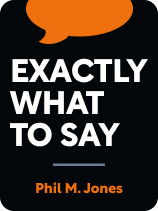

This article is an excerpt from the Shortform book guide to "Exactly What to Say" by Phil M. Jones. Shortform has the world's best summaries and analyses of books you should be reading.
Like this article? Sign up for a free trial here.
How should you respond to some of the most common sales objections? How can you save the sale when a customer objects?
In Exactly What to Say, business expert Phil M. Jones explains how to boost sales by relying on conversational selling and key phrases. In the book, he describes the most common sales objections and advises readers on what to say in response.
Read on to learn how to handle the most common sales objections, according to Jones.
Dealing With Common Sales Objections
In Exactly What to Say, sales expert Phil M. Jones explains how to avoid the dreaded customer response of “I’ll have to think about it” and how to capitalize on the conversation even if a customer says no. In this article, we’ll describe how to respond to some of the most common sales objections encountered in conversational selling, according to the advice in Exactly What to Say.
Response #1: Get More Information
The phrase, “What makes you say that?” is an effective response to many of the most common customer objections in sales because it prevents the discussion from turning into an argument and leads to more information about the other person’s needs. Instead of suggesting the customer is wrong (for example, by saying “Yes, you actually would benefit from this product.”), Jones explains that posing this question forces the person to justify their objection to the sale. The person might realize that they don’t have a strong argument for their opinion, or they could provide more transparency on their specific needs, which will help you negotiate.
For example, a common customer objection to sale is: “I don’t think your product is a good fit for me.” Using Jones’s key phrase as a response encourages the customer to tell you why exactly they think that. With this information, you can make a stronger case for why they should buy the product.
Response #2: Eliminate the Barrier
Another of the most common objections in sales is when a customer says no because of a specific limitation. In this case, Jones recommends using the sentence structure, “If I can…, then will you…” to eliminate the barrier. For example, if the customer says, “I can’t buy your product because my budget is only $100,” you respond, “If I can lower the price to $95, then will you take the deal?”
The customer will feel obligated to accept because you eliminated their justification for saying no, or they will feel they have to come up with another justification for not accepting your offer.
| “Looping” to Overcome the Most Common Sales Objections In Way of the Wolf, Jordan Belfort argues for a similar overarching strategy to overcome some of the most common sales objections, using a process called “looping.” In this process, when a prospective customer raises an objection, he recommends that you: 1. Backtrack to understand the underlying uncertainty. For example, if the person says, “I’ll have to think about it and get back to you,” ask questions to find out what their concerns are. This is similar to Jones’s technique of asking “What makes you say that?” 2. Present your argument, based on the new information. 3. Make an offer again. Steps two and three are similar to the eliminate the barrier aspect of Jones’s phrase, “If I can, then will you…?”, except you may be able to simply reframe the offer in Belfort’s process, rather than changing the terms of the offer as Jones suggests. For example, if a customer objects to your product because they’re not good at learning new software, you could present the argument that most people find your product much more user-friendly than the one your customer currently has, then offer the same product again. After these steps, Belfort recommends a repeated process of looping to address sales objections before transitioning to a final close. Although the wording of Belfort’s method is not specified, the overall goals parallel some of Jones’s phrases. |
When a time constraint is specifically posed as a barrier in sales interactions, Jones recommends the question “When would be a good time?”. When a customer hears this phrase, they subconsciously assume that there will be a good time at some point, and this pushes them to come up with a suitable time for you to continue making your case.
(Shortform note: Brian Tracy’s The Psychology of Selling argues that the question “When would be a good time?” is effective because it’s a friendly, low-pressure technique. He warns that you’re likely to fail at getting an appointment if your customer feels pressured or manipulated.)
Preempt Potential Objections
Finally, rather than having to deal with any of the most common sales objections, Jones suggests you preempt a potential objection to avoid it altogether. To avoid an objection, start the conversation with the phrase “I bet you’re a bit like me…” to get people to agree to a baseline assumption and set the stage for them to accept your offer.
For example, you could say “I bet you’re a bit like me, and you like to minimize the time you spend on administrative work, so you can do more interesting things.” Jones suggests that when you use this phrase on a stranger, they are likely to simply agree because it’s the easiest course of action. If they respond positively, they’ve already agreed to something that should logically make them want to buy your product, so it’s harder for them to refuse your pitch.
Without this phrase, it’s easy for the other person to say, “I’m not interested in that,” in response to your offer, which is difficult for you to refute.

———End of Preview———
Like what you just read? Read the rest of the world's best book summary and analysis of Phil M. Jones's "Exactly What to Say" at Shortform.
Here's what you'll find in our full Exactly What to Say summary:
- How to improve your business interactions by using key phrases
- How to appeal to your listener’s subconscious mind and guide them to a decisive “yes”
- How you can capitalize on a conversation even if a customer says "no"






